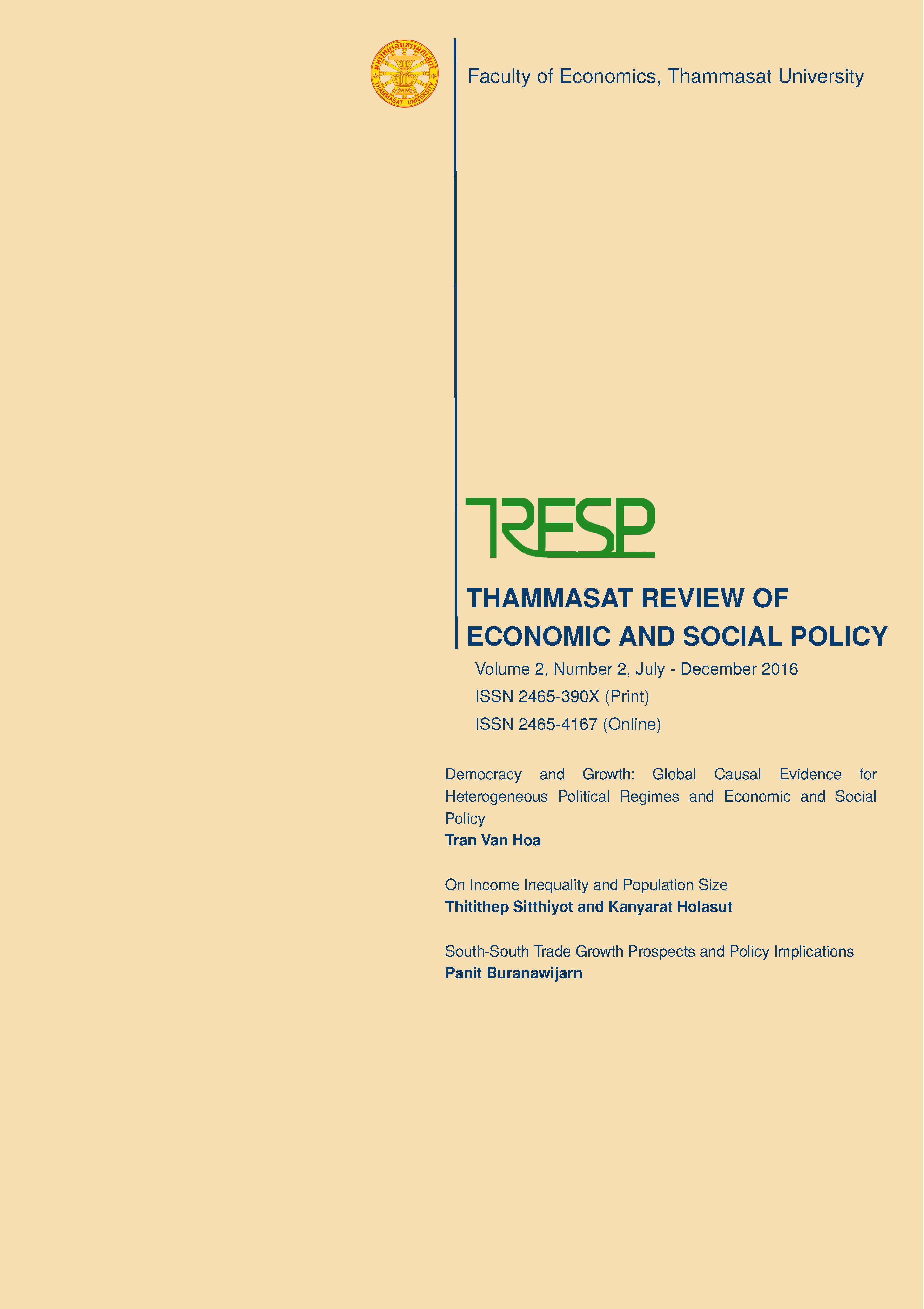On Income Inequality and Population Size
DOI:
https://doi.org/10.14456/tresp.2016.8Keywords:
Income Inequality, Gini Coefficient, Population SizeAbstract
The pursuit of having an appropriate level of income inequality should be viewed as one of the biggest challenges facing academic scholars as well as policy makers. Unfortunately, research on this issue is currently lacking. This study is the first to introduce the theoretical concept of targeted level of income inequality for a given size of population. By employing the World Bank’s data on population size and Gini coefficient from sixty-nine countries in 2012, this study finds that the relationship between Gini coefficient and natural logarithm of population size is nonlinear in the form of a second degree polynomial function. The estimated results using regression analysis show that the majority of countries in the sample have Gini coefficients either too high or too low compared to their appropriate values. These findings could be used as a guideline for policy makers before designing and implementing public policies in order to achieve the targeted level of income inequality.
References
Alesina, A. (2003). The Size of Countries: Does It Matter?. The Journal of the European Economic Association, 1 (2-3), pp. 301-316.
Bräutigam, D. & Woolcock, M. (2001). Small States in a Global Economy: The Role of Institutions in Managing Vulnerability and Opportunity in Small Developing Countries. WIDER Discussion Paper No. 2001/37. Retrieved from http://www.wider.unu.edu/sites/default/files/dp2001-37.pdf
Campante, F. & Do, Q. A. (2007). Inequality, Redistribution, and Population. KSG Faculty Research Working Paper Series No. RWP07-046. Retrieved from https://research.hks.harvard.edu/publications/workingpapers/citation.aspx?PubId=4995&type=WPN
Commonwealth Secretariat. (2000). Small States: Meeting Challenges in the Global Economy. Report of the Commonwealth Secretariat/World Bank Joint Task Force on Small States. Retrieved from http://documents.worldbank.org/curated/en/267231468763824990/Small-states-meeting-challenges-in-theglobal-economy
Deltas, G. (2003). The Small-Sample Bias of the Gini Coefficient: Results and Implications for Empirical Research. The Review of Economics and Statistics, 85 (1), pp. 226-234.
Frank, R. H. (2011). The Darwin Economy: Liberty, Competition, and the Common Good. New Jersey: Princeton University Press.
Fuentes-Nieva, R. & Galasso, N. (2014). Working for the Few: Political Capture and Economic Inequality. Oxfam Briefing Paper. Retrieved from https://www.oxfam.org/en/research/working-few
Gini Coefficient. (n.d.). In Wikipedia. Retrieved July 7, 2016, from https://en.wikipedia.org/wiki/Gini_coefficient
Phongpaichit, P. (2016). Commentary Note on Thailand’s Current Inequality Situation and Its Prospects. Thammasat Review of Economic and Social Policy, 2 (1), pp. 4-16.
Raza, S. A. (2016). r > g: Increasing Inequality of Wealth and Income Is a Runaway Process. In 2016: What Do You Consider The Most Interesting Recent [Scientific] News? What Makes It Important?. Retrieved from https://www.edge.org/annual-questions
Reuben, A. (2016, January 16). Wealth of Richest 1% ‘Equal to Other 99%’. BBC News. Retrieved from http://www.bbc.com/news/business-35339475
Soubbotina, T. P. & Sheram, K. A. (2000). Beyond Economic Growth: Meeting the Challenges of Global Development. Washington, D.C.: The World Bank.
Streeten, P. (1993). The Special Problems of Small Countries. World Development, 21 (2), pp. 197-202.
Taleb, N. N. (2012). Antifragile: Things That Gain from Disorder. New York: Random House.
The World Bank. (2016a). Gini Index (World Bank Estimate) [Data file]. Retrieved from http://data.worldbank.org/indicator/SI.POV.GINI
The World Bank. (2016b). Population Ranking [Data file]. Retrieved from http://databank.worldbank.org/data/reports.aspx?Code=SP.POP.TOTL&id=af3ce82b&report_name=Popular_indicators&populartype=series&ispopular=y



